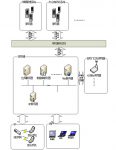
Home-school communication management based on 433MHz+125KHz dual-frequency RFID
[ad_1]
Project background
As a place for imparting knowledge and cultivating talents, schools have always received wide public attention. In particular, the safety of students has increasingly become the focus of social attention. Ensuring the safety of students and providing convenient services for the daily teaching activities of students, teachers, and parents are the basic requirements of the home-school program.
Program features and advantages
1. 433MHz RFID has the characteristics of strong diffraction, strong penetration, and long transmission distance, which is suitable for various campus environments.
2. Long card reading distance (1-5 meters adjustable), no need to swipe the card close, automatic long-distance recognition.
3. Convenient to carry. Due to the powerful diffraction performance of 433MHz, the electronic label can be placed in a school bag, or can be hung on the chest in the form of a badge or placed in the pocket of the clothes. All kinds of carrying methods can be carried. Effective identification and easy to carry.
4. Due to the strong diffraction performance of 433MHz, it solves the problem of low recognition rate caused by human body occlusion in other RFID technologies, and overcomes the false alarms and false alarms of other RFID technologies.
5. Precise control and reliable identification. The boundary of the excitation zone is clear, the boundary error is about 0.3 meters, and the signal excitation distance between the exciter and the electronic tag is within 5 meters, which overcomes other RFID technologies that are greatly affected by the climate, electromagnetic environment, and building environment. And caused the recognition rate problem.
6. The electronic tag is usually in the standby state and emits signals only when it enters the excitation zone. It has the characteristics of ultra-low power consumption, no radiation damage, and safe and reliable use.
7. Ultra-low power consumption, long service life of the electronic tag card (under normal circumstances, the battery life of the tag exceeds 5 years).
8. Allow students to enter and exit the school quickly in parallel state (maximum parallel capacity is 100 people).
9. It can be installed in the ground without affecting the appearance of the gate, and it has more advantages in the management of the entry and exit of the super wide gate.
10. 433MHz active RFID technology has the characteristics of strong penetration, strong diffraction, and long transmission distance. It is suitable for various complex environments. The exciter or reader at the receiving end only needs to be placed in the nearby duty room and connected to the computer. Can.
Schematic diagram of overall architecture

Scheme principle
The system consists of “monitoring computer”, “125KHz exciter”, “125KHz antenna” and “125KHz+433MHz dual-frequency RFID electronic tag (hereafter referred to as electronic tag)”.
Install:
1. Distribute electronic tags to students to realize one card per person.
2. An exciter is buried in the middle of the gate area, and excitation antennas are buried on both sides of the gate in and out of the direction. The excitation antenna is connected to the exciter through a buried wire tube.
3. The guard duty room near the gate installs a “125KHz exciter”, distributes a management computer and installs management system software or transmits it to the server platform through the network.
working principle:
When a student carrying an electronic tag enters the inner antenna or outer antenna excitation area of the 125KHz exciter, the electronic tag is awakened and sends a 433MHz radio frequency signal to the outside. The “125KHz excitation area” acquires the electronic tag signal and transmits the information to the monitoring computer or system The platform, monitoring computer or system platform automatically judges and records the entry and exit status of personnel according to the wake-up sequence of the internal or external excitation antenna of the electronic tag.
Schematic diagram

[ad_2]


